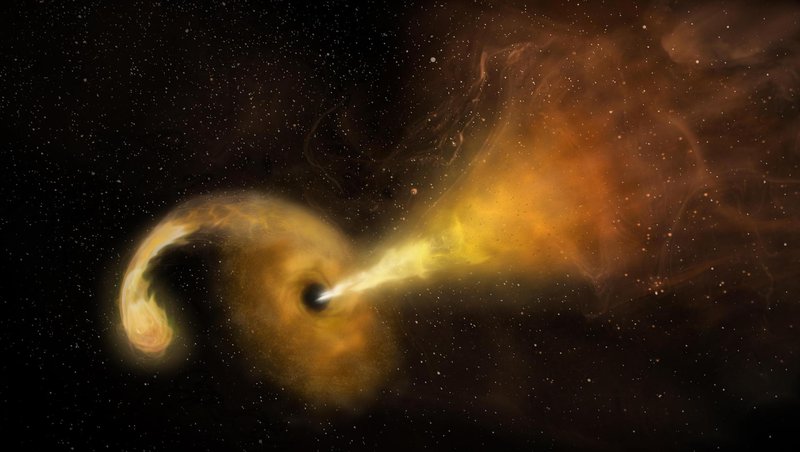
Eric Coughlin, professor of physics in Syracuse University’s College of Arts and Sciences, was recently awarded a grant from NASA for his project entitled, “Extragalactic outbursts and repeating nuclear flares from tidal disruption events.” The three-year $346,000 award will support his research on tidal disruption events (TDEs) – one of the cosmos’ most extreme occurrences where a star is completely or partially destroyed by the gravitational field of a supermassive black hole (SMBH).
By examining the formation of accretion flares – the very hot, bright shredded stellar material that falls into the black hole during a TDE – astrophysicists can gain novel insights about the evolution of SMBHs, including such demographics as their mass and spin distributions. With improvements in technology like NASA’s NICER telescope, scientists have been able to detect more TDEs than ever. While these telescopes allow scientists to make direct observations of TDEs, theoretical models are necessary to relate observations to physical properties of the disrupted star (e.g., its mass) and the disrupting black hole (e.g., its mass).
With this grant, Coughlin will work to advance TDE theory and modeling, so they are accurate and in agreement with observations. Specifically, he will numerically simulate TDEs of individual stars to generate a repository of accretion rates, which can then be used to compare to observations and infer physical properties of black holes.

An artist's concept of a tidal disruption event that happens when a star passes fatally close to a supermassive black hole, which reacts by launching a relativistic jet. (Credit: NRAO/AUI/NSF/NASA)
Part of the project will also be dedicated to understanding the production of repeating partial TDEs. A partial TDE occurs when a star is stripped of some of its mass by a SMBH but is not completely destroyed, while a repeating partial TDE is one in which the star orbits the black hole (similar to the Earth orbiting the Sun) and is stripped of mass – and fuels an electromagnetic outburst – once per orbit.
Coughlin notes that this aspect of his research shows specific promise for measuring quantities that normal tidal disruption events cannot. For example, in a TDE, there is an amount of time that passes after the star is partially disrupted and when accretion begins, known as the fallback time, and this time period is “dark”, meaning no observable emission is produced before debris rains down onto the black hole. TDEs that generate only one accretion flare cannot be used to measure this timescale.
Repeating partial TDEs, on the other hand, enable a direct detection of the fallback time through the electromagnetic disturbances that arise as the star orbits the SMBH. The fallback time can also be reliably measured from simulations, but its value changes as a function of the star’s and the black hole’s mass, meaning that repeating partial TDEs provide a unique test of the theoretical understanding of strong tides and probe the properties of black holes (and stars in distant galaxies).
“Our goal is to develop an enhanced understanding of the variability in the accretion rates onto black holes that can be generated by tidal disruption events, ultimately to better inform our physical modeling of observations,” says Coughlin. “Our results will support the mission of NASA's Physics of the Cosmos program: to understand the behavior of matter in extreme environments and the evolution of the Universe.”
This is the second NASA grant currently held by Coughlin, with his other entitled, “Continued Swift monitoring of repeating stellar tidal disruption events: Towards a legacy dataset.” This proposal involves using data from the Neil Gehrels Swift Observatory (an optical-UV+X-ray telescope) to probe properties of repeating partial TDEs. His research is also presently funded by a $330,000 National Science Foundation grant for a project entitled, “Understanding the long-term evolution of tidal disruption events.”
